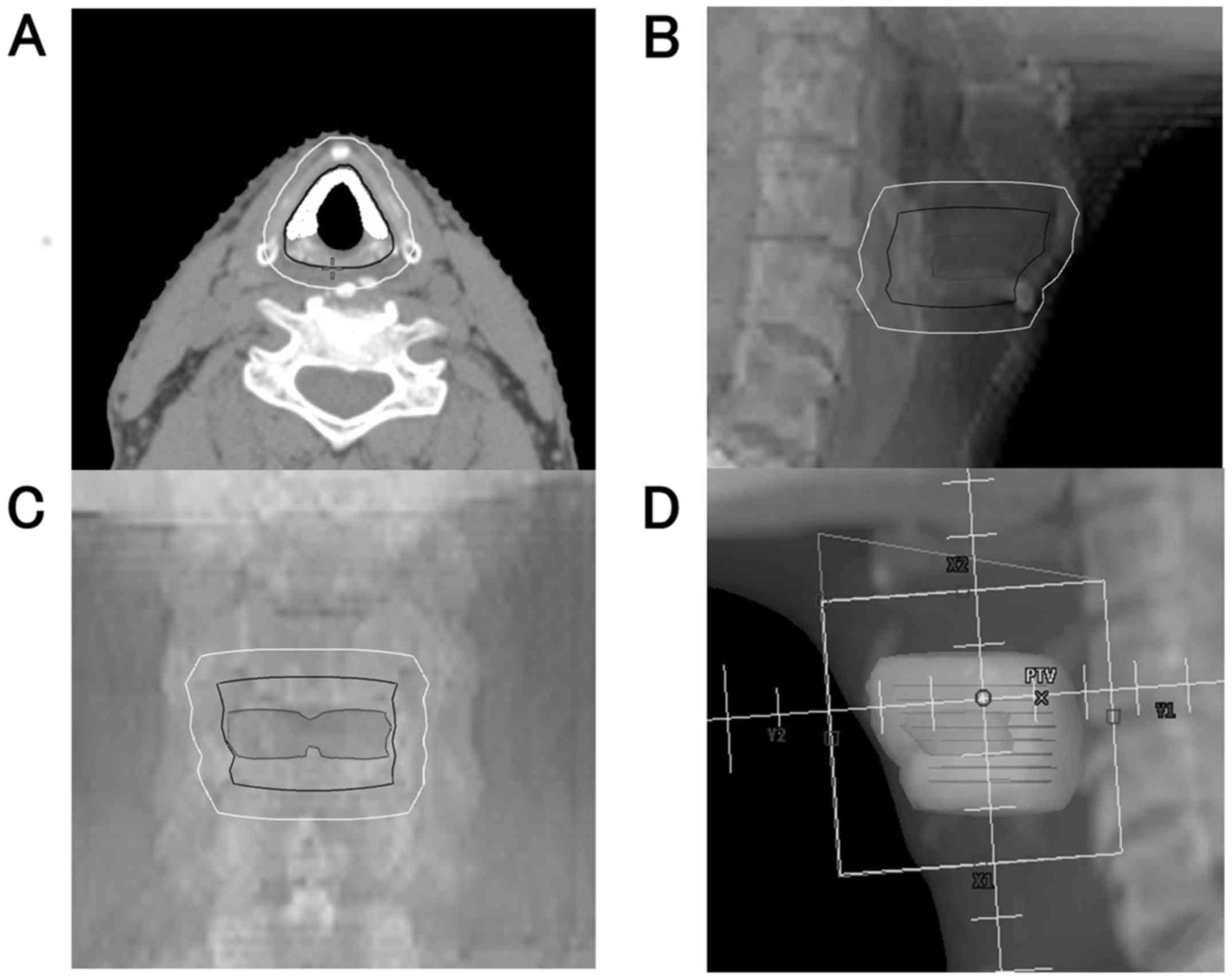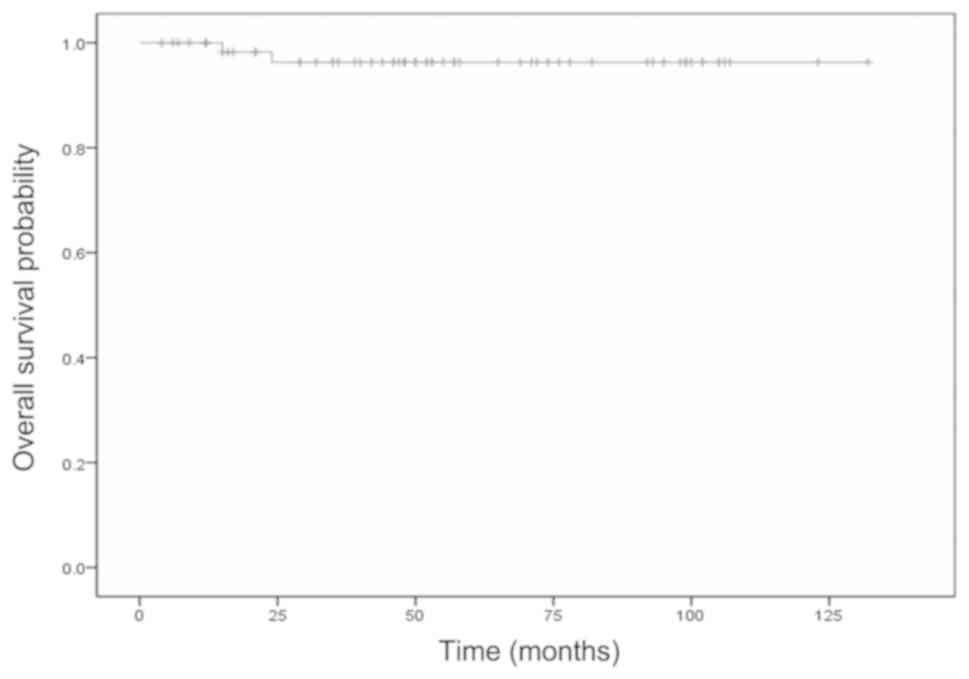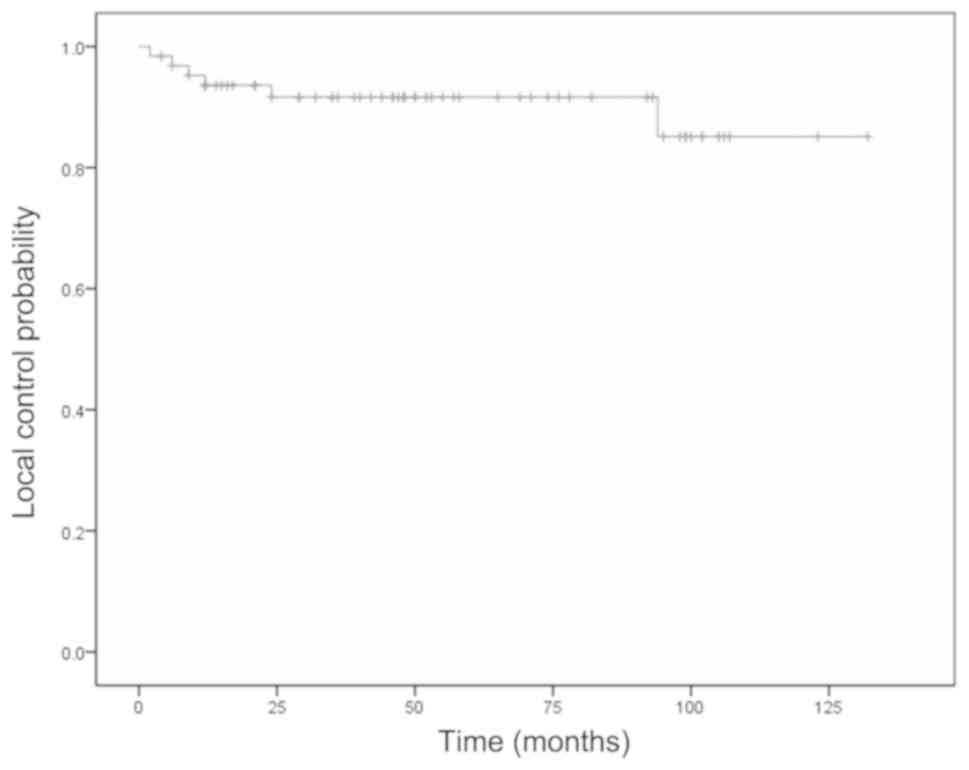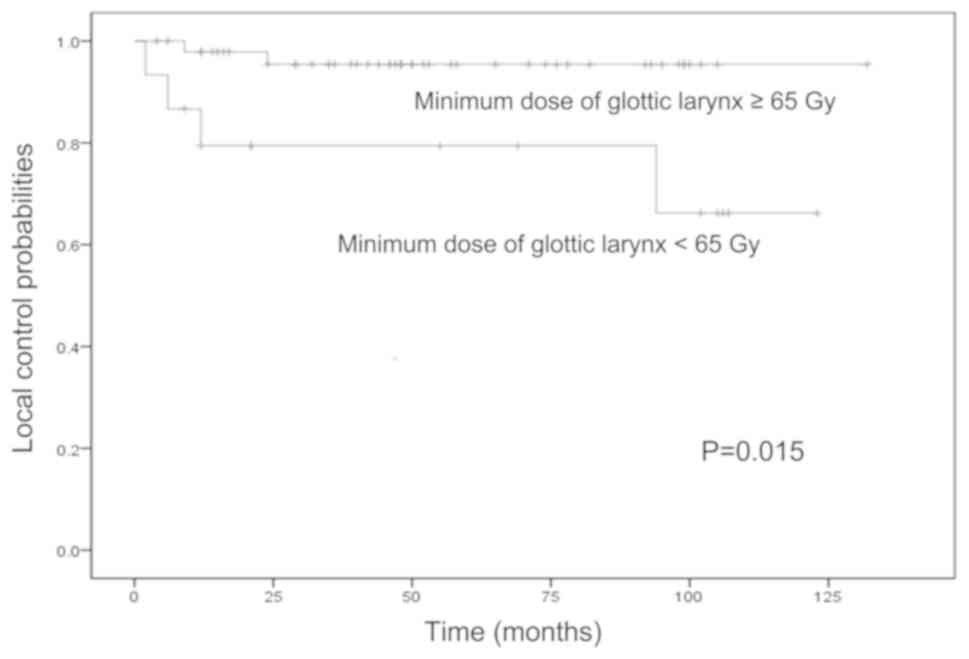|
1
|
Mendenhall WM, Werning JW, Hinerman RW,
Amdur RJ and Villaret DB: Management of T1-T2 glottic carcinomas.
Cancer. 100:1786–1792. 2004.PubMed/NCBI View Article : Google Scholar
|
|
2
|
Beitler JJ and Johnson JT: Transoral laser
excision for early glottic cancer. Int J Radiat Oncol Biol Phys.
56:1063–1036. 2003.PubMed/NCBI View Article : Google Scholar
|
|
3
|
Back G and Sood S: The management of early
laryngeal cancer: Options for patients and therapists. Curr Opin
Otolaryngol Head Neck Surg. 13:85–91. 2005.PubMed/NCBI View Article : Google Scholar
|
|
4
|
Akine Y, Tokita N, Ogino T, Tsukiyama I,
Egawa S, Saikawa M, Ohyama W, Yoshizumi T and Ebihara S:
Radiotherapy of T1 glottic cancer with 6 MeV X rays. Int J Radiat
Oncol Biol Phys. 20:1215–1218. 1991.PubMed/NCBI View Article : Google Scholar
|
|
5
|
Fein DA, Lee WR, Hanlon AL, Ridge JA,
Curran WJ and Coia LR: Do overall treatment time, field size, and
treatment energy influence local control of T1-T2 squamous cell
carcinomas of the glottic larynx? Int J Radiat Oncol Biol Phys.
34:823–831. 1996.PubMed/NCBI View Article : Google Scholar
|
|
6
|
Mendenhall WM, Parsons JT, Stringer SP,
Cassisi NJ and Million RR: T1-T2 vocal cord carcinoma: A basis for
comparing the results of radiotherapy and surgery. Head Neck Surg.
10:373–377. 1988.PubMed/NCBI View Article : Google Scholar
|
|
7
|
Rudoltz MS, Benammar A and Mohiuddin M:
Prognostic factors for local control and survival in T1 squamous
cell carcinoma of the glottis. Int J Radiat Oncol Biol Phys.
26:767–772. 1993.PubMed/NCBI View Article : Google Scholar
|
|
8
|
Small W Jr, Mittal BB, Brand WN, Shetty
RM, Rademaker AW, Beck GG and Hoover SV: Results of radiation
therapy in early glottic carcinoma: Multivariate analysis of
prognostic and radiation therapy variables. Radiology. 183:789–794.
1992.PubMed/NCBI View Article : Google Scholar
|
|
9
|
Reddy SP, Hong RL, Nagda S and Emami B:
Effect of tumor bulk on local control and survival of patients with
T1 glottic cancer: A 30-year experience. Int J Radiat Oncol Biol
Phys. 69:1389–1394. 2007.PubMed/NCBI View Article : Google Scholar
|
|
10
|
Sakata K, Aoki Y, Karasawa K, Hasezawa K,
Muta N, Nakagawa K, Terahara A, Onogi Y, Sasaki Y and Akanuma A:
Radiation therapy in early glottic carcinoma: Uni- and multivariate
analysis of prognostic factors affecting local control. Int J
Radiat Oncol Biol Phys. 30:1059–1064. 1994.PubMed/NCBI View Article : Google Scholar
|
|
11
|
Nishimura Y, Nagata Y, Okajima K,
Mitsumori M, Hiraoka M, Masunaga S, Ono K, Shoji K and Kojima H:
Radiation therapy for T1,2 glottic carcinoma: Impact of overall
treatment time on local control. Radiother Oncol. 40:225–232.
1996.PubMed/NCBI View Article : Google Scholar
|
|
12
|
Mendenhall WM, Parsons JT, Million RR and
Fletcher GH: T1-T2 squamous cell carcinoma of the glottic larynx
treated with radiation therapy: Relationship of dose-fractionation
factors to local control and complications. Int J Radiat Oncol Biol
Phys. 15:1267–1273. 1988.PubMed/NCBI View Article : Google Scholar
|
|
13
|
Amin MB, Edge S, Greene F, Byrd DR,
Brookland RK, Washington MK, Gershenwald JE, Compton CC, Hess KR,
Sullivan DC, et al: (eds): AJCC Cancer Staging Manual. 8th edition.
New York, Springer International Publishing, 2017.
|
|
14
|
National Cancer Institute. Common
Terminology Criteria for Adverse Events (CTCAE) [Internet], 2018
(cited 2019 Aug 5). Available from: https://ctep.cancer.gov/protocoldevelopment/electronic_applications/ctc.htm#ctc_50.
|
|
15
|
Kataria T, Sharma K, Subramani V,
Karrthick KP and Bisht SS: Homogeneity index: An objective tool for
assessment of conformal radiation treatments. J Med Phys.
37:207–213. 2012.PubMed/NCBI View Article : Google Scholar
|
|
16
|
Zhao KL, Liu G, Jiang GL, Wang Y, Zhong
LJ, Wang Y, Yao WQ, Guo XM, Wu GD, Zhu LX, et al: Association of
haemoglobin level with morbidity and mortality of patients with
locally advanced oesophageal carcinoma undergoing radiotherapy-a
secondary analysis of three consecutive clinical phase III trials.
Clin Oncol (R Coll Radiol). 18:621–627. 2006.PubMed/NCBI View Article : Google Scholar
|
|
17
|
Shin NR, Lee YY, Kim SH, Choi CH, Kim TJ,
Lee JW, Bae DS and Kim BG: Prognostic value of pretreatment
hemoglobin level in patients with early cervical cancer. Obstet
Gynecol Sci. 57:28–36. 2014.PubMed/NCBI View Article : Google Scholar
|
|
18
|
Al-Mamgani A, van Rooij PH, Woutersen DP,
Mehilal R, Tans L, Monserez D and aatenburg de Jong RJ:
Radiotherapy for T1-2N0 glottic cancer: A multivariate analysis of
predictive factors for the long-term outcome in 1050 patients and a
prospective assessment of quality of life and voice handicap index
in a subset of 233 patients. Clin Otolaryngol. 38:306–312.
2013.PubMed/NCBI View Article : Google Scholar
|
|
19
|
Eskiizmir G, Baskın Y, Yalçın F, Ellidokuz
H and Ferris RL: Risk factors for radiation failure in early-stage
glottic carcinoma: A systematic review and meta-analysis. Oral
Oncol. 62:90–100. 2016.PubMed/NCBI View Article : Google Scholar
|
|
20
|
Franchin G, Minatel E, Gobitti C, Talamini
R, Sartor G, Caruso G, Grando G, Politi D, Gigante M, Toffoli G, et
al: Radiation treatment of glottic squamous cell carcinoma, stage I
and II: Analysis of factors affecting prognosis. Int J Radiat Oncol
Biol Phys. 40:541–548. 1998.PubMed/NCBI View Article : Google Scholar
|
|
21
|
Marshak G, Brenner B, Shvero J, Shapira J,
Ophir D, Hochman I, Marshak G, Sulkes A and Rakowsky E: Prognostic
factors for local control of early glottic cancer: The Rabin
Medical Center retrospective study on 207 patients. Int J Radiat
Oncol Biol Phys. 43:1009–1013. 1999.PubMed/NCBI View Article : Google Scholar
|
|
22
|
Narayana A, Vaughan AT, Kathuria S, Fisher
SG, Walter SA and Reddy SP: P53 overexpression is associated with
bulky tumor and poor local control in T1 glottic cancer. Int J
Radiat Oncol Biol Phys. 46:21–26. 2000.PubMed/NCBI View Article : Google Scholar
|
|
23
|
Cellai E, Frata P, Magrini SM, Paiar F,
Barca R, Fondelli S, Polli C, Livi L, Bonetti B, Vitali E, et al:
Radical radiotherapy for early glottic cancer: Results in a series
of 1087 patients from two Italian radiation oncology centers. I.
The case of T1N0 disease. Int J Radiat Oncol Biol Phys.
63:1378–1386. 2005.PubMed/NCBI View Article : Google Scholar
|
|
24
|
Nur DA, Oguz C, Kemal ET, Ferhat E, Sülen
S, Emel A, Münir K, Ann CS and Mehmet S: Prognostic factors in
early glottic carcinoma implications for treatment. Tumori.
91:182–187. 2005.PubMed/NCBI
|
|
25
|
Murakami R, Nishimura R, Baba Y, Furusawa
M, Ogata N, Yumoto E and Yamashita Y: Prognostic factors of glottic
carcinomas treated with radiation therapy: Value of the adjacent
sign on radiological examinations in the sixth edition of the UICC
TNM staging system. Int J Radiat Oncol Biol Phys. 61:471–475.
2005.PubMed/NCBI View Article : Google Scholar
|
|
26
|
Tong CC, Au KH, Ngan RK, Cheung FY, Chow
SM, Fu YT, Au JS and Law SC: Definitive radiotherapy for early
stage glottic cancer by 6 MV photons. Head Neck Oncol.
4(23)2012.PubMed/NCBI View Article : Google Scholar
|
|
27
|
Berwouts D, Swimberghe M, Duprez F,
Boterberg T, Bonte K, Deron P, De Gersem W, De Neve W and Madani I:
Intensity-modulated radiotherapy for early-stage glottic cancer.
Head Neck. 38 (Suppl 1):E179–E184. 2016.PubMed/NCBI View Article : Google Scholar
|
|
28
|
Zumsteg ZS, Riaz N, Jaffery S, Hu M,
Gelblum D, Zhou Y, Mychalczak B, Zelefsky MJ, Wolden S, Rao S and
Lee NY: Carotid sparing intensity-modulated radiation therapy
achieves comparable locoregional control to conventional
radiotherapy in T1-2N0 laryngeal carcinoma. Oral Oncol. 51:716–723.
2015.PubMed/NCBI View Article : Google Scholar
|


















